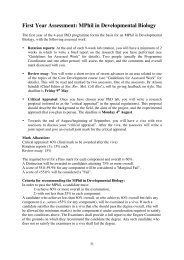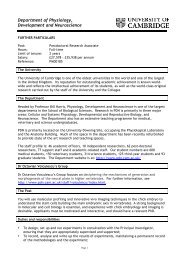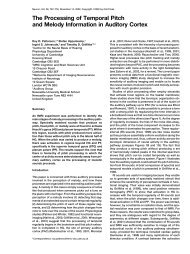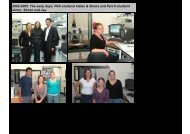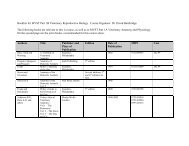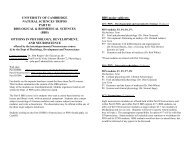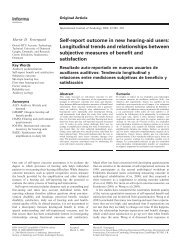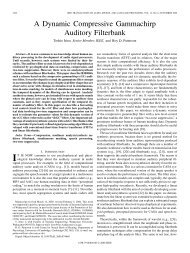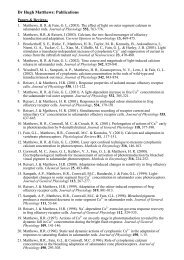part ii physiology, development and neuroscience - Department of ...
part ii physiology, development and neuroscience - Department of ...
part ii physiology, development and neuroscience - Department of ...
You also want an ePaper? Increase the reach of your titles
YUMPU automatically turns print PDFs into web optimized ePapers that Google loves.
PRACTICALS<br />
Your project supervisor may want you to take one or more <strong>of</strong> the following practicals as an introduction<br />
to techniques to be used in your project.<br />
The Microelectrodes Classes<br />
The experiments performed in the two Microelectrode practical classes directly relate to topics in Cellular<br />
Physiology (P1). The practical techniques <strong>and</strong> data analysis introduced are relevant to numerous other<br />
modules, most notably Control <strong>of</strong> Action (N3) <strong>and</strong> Sensory Transduction (N4). Students doing one <strong>of</strong> the<br />
many experimental projects <strong>of</strong>fered each year in this area <strong>of</strong> <strong>physiology</strong> are advised to attend one or<br />
both <strong>of</strong> these classes.<br />
Microelectrodes I: Basic Intracellular Recording from Frog Skeletal Muscle<br />
The objectives are to provide a h<strong>and</strong>s-on introduction to basic microelectrode techniques used in cellular<br />
neuro<strong>physiology</strong> <strong>and</strong> to introduce the recording <strong>and</strong> analysis <strong>of</strong> basic electrophysiological phenomena in<br />
striated muscle. The class will introduce you to basic equipment used in measuring bioelectric potentials,<br />
<strong>and</strong> to the setting up <strong>of</strong> amphibian striated muscle preparations as an experimental model on which to<br />
perform such work. You should acquire sufficient confidence <strong>and</strong> skill during the class to apply these<br />
techniques in recording, <strong>and</strong> analysing electrical activity in excitable cells.<br />
Pr<strong>of</strong>. Chris Huang<br />
Microelectrodes II: Recording <strong>of</strong> Excitable Activity from Frog Skeletal Muscle<br />
It is essential that you have attended Microelectrodes I in order to take <strong>part</strong> in these experiments.<br />
This set <strong>of</strong> experiments takes the studies represented by the Microelectrodes I class further. You will<br />
record <strong>and</strong> analyse the factors that modify the action potential, extending these to an analysis <strong>of</strong> the<br />
factors that determine voltage spread <strong>and</strong> conduction velocity.<br />
Pr<strong>of</strong>. Chris Huang<br />
Loose Patch Clamp Recording<br />
This practical will give you an improved underst<strong>and</strong>ing <strong>of</strong> the classic Nobel prize-winning experiments <strong>of</strong><br />
Hodgkin <strong>and</strong> Huxley on the conductances underlying the action potential. In addition it provides h<strong>and</strong>son<br />
experience <strong>of</strong> a simplified forerunner <strong>of</strong> the now-ubiquitous (<strong>and</strong> also Nobel prize-winning) patch<br />
clamp technique, which has revolutionised all areas <strong>of</strong> cellular <strong>physiology</strong>.<br />
You will investigate the voltage <strong>and</strong> time dependent sodium <strong>and</strong> potassium conductances which underlie<br />
the action potential <strong>of</strong> frog sartorius muscle. You will record the ionic currents flowing across the muscle<br />
membrane under voltage clamp using the loose patch clamp technique. From these records you will be<br />
able to study the voltage-dependent gating <strong>of</strong> the sodium <strong>and</strong> potassium conductances underlying the<br />
action potential. You will also use a computer model incorporating the Hodgkin-Huxley equations to<br />
simulate some <strong>of</strong> the experiments which you carry out, in order to improve your underst<strong>and</strong>ing <strong>of</strong> the<br />
way in which these conductances depend on membrane potential.<br />
This Practical relates directly to material covered in Cellular Physiology (P1), but the concepts underlying<br />
the loose patch clamp technique are relevant to numerous others <strong>of</strong> the more reductionistic physiological<br />
<strong>and</strong> neurobiological modules. Attendance at the practical will also provide important training for certain<br />
electrophysiological projects.<br />
Dr Hugh Matthews<br />
20



